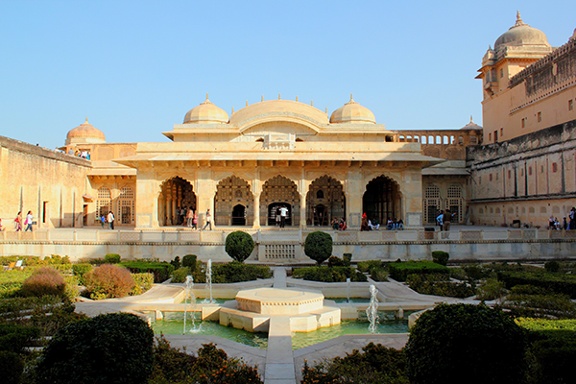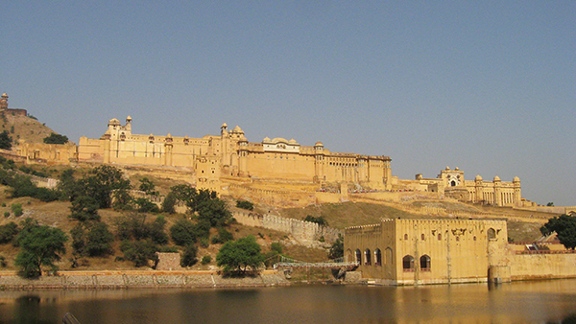National Garden Month: Amer Fort
I can’t think of a more appropriate month for National Garden Month than April, when we are fresh from winter and want to go outside and see flowers. April was first declared National Garden Month in 2015. I would prefer that it be called World Garden Month, because there are gardens all over the world that celebrate the joy of blooming. And gardens contain spiritual meanings of all sorts in many cultures.
 |
| India, Amer Fort, chahar bagh (four gardens) and the Sukh-Niwas (Comfort House), Jaipur, 1562–1592 through 1700s. Photo: Arastugupta. CC BY-SA 3.0 DEED. (8S-10106) |
The third courtyard of Amer Fort is where the raj's families and their attendants lived. It is covered in mosaics and contains the Sukh-Niwas (comfort house or hall of rest). Between the Sukh-Niwas and the other building on this court is a chahar bagh (Farsi for “four gardens”). This is a rectangular or square garden divided into four sections by paths leading in the four cardinal directions. There is a fountain at the intersection of the paths.
The chahar bagh is thought to have originated in ancient Persian palaces of the Achaemenid period (530–330 BCE), where they were referred to as “paradise gardens.” The oldest type of chahar bagh is located in Pasargadae, the first capital of the Achaemenid dynasty, in present-day Iran. After the Muslim conquest, its use spread throughout the Muslim world. It became a popular feature of palaces and tombs in Mughal India. The chahar bagh is also sometimes referred to as a “paradise garden” because it is thought to symbolize the gardens of paradise promised to the faithful in the Qur'an (Chapter 55, verses 46 and 62).
Islam began to spread in India in the 700s CE, when Arab armies invaded parts of northern India. By the 1000s CE, missionaries from countries such as Saudi Arabia, Yemen, and Iran were moving to India to spread Islam. The Turkish general Qutb ud-Din Aybak (1150–1210) was almost single-handedly responsible for conquering most of northern India and current-day Pakistan for Islam. In 1526, the Turk/Mongol leader Babur (1483–1530) founded the Mughal Empire when he invaded and conquered northern India (including Pakistan).
Under Babur’s successors, especially Jalaluddin Muhammad Akbar (sometimes called Akbar the Great) (1542–1605), the empire grew to encompass three-quarters of the Indian subcontinent. The grandson of Babur, Akbar is considered the greatest of Mughal emperors of India. He consolidated and expanded the empire to include Malwa, Gujarat, Bengal, Kabul, Kashmir, and Kandesh, among other provinces. At the time, the Mughal Empire included both Hindus and Muslims. Akbar fostered an atmosphere of tolerance, repealing the jizya, a tax on non-Muslims.
Amer Fort was constructed on the site of a structure built by the Meenas family of rulers. After army commander Maharaja Man Singh (1550–1614) defeated the Meenas, he took control of the Rajput, the patrilineal clan landowners in northern and central India. As ruler, Man Singh built Amer fort. The fort is divided into four sections, each with its own grand entrance gate. It overlooks Lake Maota and is located north of Jaipur.
Successors of Man Singh upgraded and added to Amer Fort into the 1700s. It is a combination of Mughal and Rajput architectural styles, built from rose and white sandstone and adorned with white marble. Man Singh's descendant, Jai Singh II (1688–1743), moved the capital from Amer to Jaipur in 1727.
 |
| India, Amer Fort, from Lake Maota, Jaipur, 1562–1592, through 1700s. Photo: Shashikantha521. CC BY-SA 3.0 DEED. (8S-10103) |
Correlations to Davis programs: Explorations in Art 2E Grade 1: 1.2; Explorations in Art 2E Grade 3: 4.8; A Global Pursuit 2E: 3.5; Discovering Art History 4E: Chapter 4


Comments